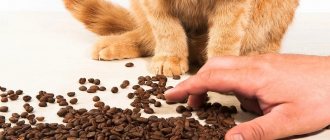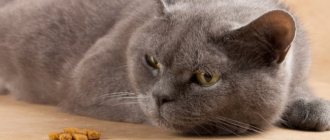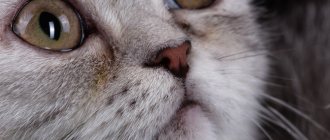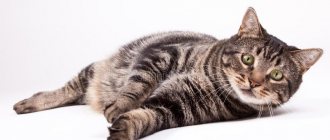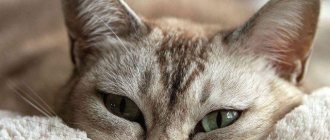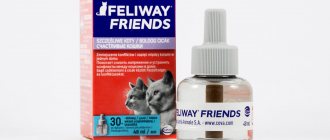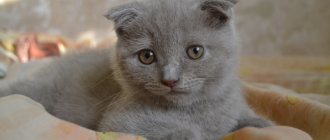When a person adopts not a kitten, but an adult pet, sometimes he is faced with the fact that the cat categorically does not eat dry food. Most often this happens because the cat got used to eating something else while living with the previous owner or on the street. Volunteers at the Murkosha shelter often encountered a similar problem and over time developed a specific strategy that helps transfer the cat to dry food.
1) The benefits of dry food 2) Why an adult cat does not eat dry food 3) Why a kitten does not eat dry food 4) Features of accustoming to dry food
Why is it important to monitor your baby's appetite?
“Beginner” owners probably have a question: why and where does so much fuss and indignation come from when it comes to some kind of appetite? Is it really so important that it be regular, full and healthy? In fact, as was mentioned just above, appetite is almost a key indicator not only of health, but also of the baby’s overall condition. For example, as soon as he is literally torn away from his mother, he experiences strong emotional experiences and may lose his appetite, which will tell us that not everything is in order with the animal’s condition.
Backup options
It is important to open the briquette with food right in front of the cat. Most animals will be attracted to this and will gobble up the food with interest. There is another interesting method - feeding the cat from your finger. The fact is that many cats will never touch the food in the bowl. They will lick this same food off their finger with great pleasure. Let’s assume that the animal simply didn’t taste the food. But finger feeding will help you quickly get used to the food in his bowl. It is even possible to slightly open his mouth so that he can quickly feel the taste of food. If the kitten does not eat dry food, you now know what to do.
The cat is tired of the taste or consistency
Cats, like people, get tired of the same food over time. If your pet eats the same food for a long time, he may simply get bored with it and want variety. If your four-legged pet suddenly begins to refuse his usual food, perhaps it’s not that it’s spoiled or the bowl smells of something, he just doesn’t like it anymore.
Refusal to feed is a kind of blackmail on the part of the tailed cunning creature. Thus, he tries to beg the owner for something more tasty. You should not force your four-legged picky eater to eat the food he usually eats. It is better to change the brand of food after coordinating your choice with your veterinarian. The transition from one finished product to another should be gradual. This process should take 1–1.5 weeks.
Different foods for lunch
If your cat is picky about dry food, prefers a certain flavor and manufacturer, and the bag or packaging with the one she doesn’t like is large, then you can try adding a little of it to her favorite food and mix.
But under no circumstances should you mix different types of food. Cats prefer separate meals. Adding pieces of meat to sour cream or milk will not lead to anything good. The same goes for dry food and canned meat. Such foods should always be given separately, but in such a way that the animal always has a separate bowl of clean water to drink.
The reason is in the bowl (dirty, smelly, etc.)
Cats are extremely clean animals. Their sense of smell is much sharper than that of humans, so they are able to smell even a faint odor. A pet may stop eating its usual food because the owner rarely washes the bowl or it smells unpleasant for reasons not related to untimely washing. Liquid from the bowl of water may leak into the container containing the dry granules. That is why it is recommended to place them at a certain distance from each other to eliminate this problem.
When moisture gets into the food, it begins to become damp. If the animal does not completely eat the food at one time, microorganisms grow in it, as a result of which it begins to smell unpleasant.
What can you do to restore your four-legged pet’s interest in food? To do this you need:
- Wash the bowl and pour boiling water over it. Subsequently, do this every day.
- Place the container of water away from the food bowl, making sure that the contents of the first cannot get into the latter. Some cat owners prefer to use double bowls. This is not the best option. It is recommended to feed cats from separate bowls.
- Pour into the bowl exactly as many granules as your pet can eat at a time. If he has not finished eating, it is recommended to pour the food back into the storage container, discarding the top layer on which the animal’s saliva has fallen.
- When purchasing food bowls, give preference to glass or stainless steel ones. Plastic containers may smell unpleasant. In addition, plastic is porous and almost impossible to wash clean.
The kitten is sick
You should really worry only when the kitten refuses any food, not just dry food. As a rule, loss of appetite is accompanied by other symptoms - lethargy, discharge from the nose and eyes, upset bowel movements, vomiting, and fever. In this case, you should definitely consult a doctor.
The most common reasons why a kitten does not want to eat dry food are the whims of the pet and the inappropriate composition of the product. Take these moments seriously, learn to understand dry food and start developing the right eating habits in your baby - then you won’t have any problems feeding your kitten.
Read also: New buildings of PIK Group of Companies
When force feeding is contraindicated
Animal instincts tell them a rational line of behavior, so a sick animal loses its appetite.
However, there are conditions where force feeding will actually do more harm than good. These are:
- Poisoning. In this case, actions are taken aimed at increasing the removal of the toxic substance from the body (artificially inducing vomiting, giving a cleansing enema, giving a laxative, intravenous infusions) and slowing down its absorption into the blood.
- Shock after injury. Pain and severe stress contribute to a sharp shift in metabolism and inappropriate behavior. As first aid, urgent measures are required to stop bleeding, fix the injured part of the body, as well as administer sedatives and cardiac drugs.
- Condition after anesthesia and surgery. Disorientation in space, dullness of sensitivity and disruption of muscle function lead to the loss of habitual behavioral reactions. Depending on the specifics of the surgical intervention, fasting is prescribed for 24-78 hours, and only after complete recovery from anesthesia and stabilization of the condition, dietary feeding with a gradual expansion of the diet is indicated.
- Acute gastrointestinal infection of a bacterial or viral nature. In this case, it is necessary to take emergency measures to relieve vomiting, diarrhea and general intoxication by introducing antibiotics, immunostimulants, sorbents, antispasmodics and detoxification drugs into the body.
- An attack of acute pancreatitis. For 2-3 days, the sick animal is shown fasting with intravenous administration of medicinal solutions, and only subsequently – fractional feeding in small portions.
Dehydration is much more dangerous than starvation, so drinking enough fluid or (in severe cases) intravenous infusion of special solutions that restore water-salt balance is a priority in all pathological conditions.
Eating disorder
The reason why a cat does not eat dry food may be constant feeding of other foods. Many owners like to treat their pets to wet diets, considering them just a treat or treat. At the same time, it is a food that contains enough calories to curb your appetite.
Usually, cats spoiled in this way begin to demand something tasty, ignoring the dry food in the bowl, and are so insistent that the owners give their pet a snack again and again, and then worry about giving up the dry food.
Another fairly common situation is non-compliance with feeding standards. Dry food pours out in a heap, and since cats tend to approach the bowl 10–15 times a day and eat a little, the owners, without noticing this and constantly contemplating a full bowl, conclude that their pet is not eating .
One has only to determine and weigh the daily requirement to the nearest gram, and it turns out that the cat copes with it perfectly. It is best to pour half a serving in the morning and half in the evening, then it will be even easier for you to determine how much your pet has eaten.
Owner behavior as a cause of deterioration in appetite in cats
Someone may be surprised by this formulation of the question, but sometimes a deterioration in appetite in cats or pickiness in food is a consequence of the behavior of the owners. If, at the first request of a cat, they change the type or taste of food, at the first refusal of dry food they offer wet food, if they buy food with a questionable or inconsistent composition, the likelihood of whims increases. Animals begin to manipulate their owners in order to get what they want.
If the cat feels well and the quality of the food is fine, do not rush to make any changes to the diet on the first day, watch for purring. If the appetite remains poor, you can, of course, offer your cat food with a different flavor, but do not buy the entire pet store trying to find the right one, so as not to turn your pet into a picky eater.
Many owners, when their pet has a poor appetite, act on the principle of “knocking out a wedge with a wedge”, do not feed the cats for several days in a row and wait until they are so hungry that they eat what they should eat, in the opinion of the owners. There is a common expression that no one has ever died with a full bowl, but here it is important not to go to extremes. You can let your cat starve not as a punishment, but understanding its possible need for temporary fasting, but, as indicated in the section on medical reasons, do not allow your pet to starve for more than a day, and certainly do not contribute to this with your actions, do not deprive the cat of food for a long time in to awaken appetite.
Another simple, but not always obvious reason for poor appetite in cats can be banal overfeeding. The cat is full, so it doesn’t eat, and the owner thinks that the poor thing is starving and refuses food. Determine the daily amount of food required for your pet, pour food into the bowl not by eye, but according to the norm, and monitor how much the cat eats.
If the daily amount of food is not completely eaten, determine how much the cat is not eating; the amount of uneaten food within 20% of the daily norm is not a reason to panic. When a cat eats much less than it should normally, this is a reason to analyze all the above factors and take appropriate actions.
Dry food is a new food for a kitten
If your pet was not accustomed to dry food before coming into your home, then, of course, at first he will look at the new food with suspicion. Therefore, he needs to be introduced to it gradually, first by gradually mixing it with the food to which the baby is accustomed, and every day increasing the share of dry food in the total volume.
Soaking the granules in warm water can also help with habituation. Once slightly soaked, they will acquire a softer texture, and the kitten will be more accustomed to such food. You can read more about how to properly soak kitten food here.
The kitten is naughty
All family members want to pamper the baby, and this desire is quite understandable, but food is not the best, and in any case, not the healthiest way to show your affection. Communication and games are much more important to a kitten, but additional treats can only lead to overeating, although the dry food in the bowl will remain untouched.
Constant chaotic treats also have another danger - the kitten may begin to systematically “extort” tasty treats from each family member in turn, and they, out of the kindness of their hearts, will feed the pet everything that it does not ask for. This situation does not lead to anything good - from digestive disorders to the appearance of excess weight.
Do not follow the kitten’s lead, feed in accordance with the recommended norm, and if the baby is naughty, do not give him anything other than dry food, and warn all family members about this. As a rule, after a few hours of the fast, the appetite returns.
How much should you feed a kitten?
Newborn kittens are fed on their mother's milk and receive all their nutrition entirely from her. If for some reason the kitten does not have a mother, then they are fed with specialized formulas for kittens. Kittens are weaned from their mother at approximately three to four weeks of age, and from this point onwards they can be introduced to dry food in alternation or by mixing it with wet food.
You may like: What does a Himalayan bear eat?
Kittens need food rich in protein and calcium.
After he is weaned from his mother, he should not be given any more dairy products, especially cow's milk.
Once weaned from their mother, they can eat both dry and wet food. Start feeding him dry food that has been canned or soaked into oatmeal.
Over the next two weeks, gradually reduce the amount of water and increase the portion of food.
By six to eight weeks they will switch to dry food without any problems.
The amount of feed is indicated on the packaging by the manufacturer; follow these proportions.
The portion can be served immediately or divided into two portions.
Kitten doesn't like dry food
This happens if the ready-made industrial diet is not complete enough for a small predator. Animals determine the composition of food by smell, and the most significant for them is the aroma of meat or fish, as well as the corresponding fats. If a kitten does not feel these components in food, then it will refuse it for a very understandable reason: such food is not suitable for it.
Therefore, when choosing dry food, pay attention, first of all, to the number of meat components in its composition; they should form the entire basis of the diet, that is, occupy at least the first five places in the list of ingredients. You can get a complete picture of what dry cat food should be like from this article.
Rules for switching to new food
When changing your usual diet, you need to be patient and consistent. You should not scold an animal or indulge it when it presses for pity. A sharp transition is harmful to health, so the new food needs to be mixed a little with the old one. On average, this takes 1-2 weeks.
Frequent product changes are harmful!
Frequently changing brands is fraught with problems with the gastrointestinal tract. To avoid diarrhea and constipation, veterinarians recommend sticking to a specific brand even on a therapeutic diet. This is not so difficult, since most manufacturers produce several lines that take into account the age and other characteristics of the animal.
Transition from straight
It's not safe to mix different types of foods, so don't be surprised by temporary bowel problems. In this case, this cannot be avoided, so be patient and adhere to the following scheme:
- 25% “drying” and 75% natural – 1-4 days;
- 50% of each type – 5-9 days;
- 75% “drying” and 25% natural – 9-14 days.
At the end of 2 weeks, pellets should make up 100% of the diet. For the first 4 days, you can soak them a little in water so that your pet is not scared off by the unusual consistency.
Switching from wet food
Feeding only wet canned food softens the gums, causing increased bleeding and premature tooth loss. For this reason, they should be combined with dry granules.
The principle of transition here is similar to the previous point. The only difference is that the final proportion must correspond to the instructions on the food packaging. There are detailed rules for feeding animals with 2 types of food.
Please note that increasing the amount of dry kibble will require a large amount of liquid to digest it. Make sure your pet drinks enough water and replace it with fresh water regularly.
Switching from one brand of granules to another
“Crusks” of different brands differ in taste, smell, shape and consistency. Because of this, animals have many reasons to ignore a new type of food.
If your pet selectively eats the granules that are familiar to him, try lubricating the new food with spider jelly. The taste and smell of meat pieces are more intense, so the cat will eat food unfamiliar to him with great pleasure.
Mix in the new food gradually and monitor the reaction. If your pet does not have health problems, do not add a new portion until he eats what is left in the bowl. Thanks to hunger, the cat will eventually come to terms with the new diet and will not be picky.
Conclusion
If your cat doesn’t want to eat dry food, don’t scold her and try to figure out the reason for her refusal. In most cases, the problem that arises is associated with errors made in care and maintenance. All of them can be fixed and are not critical, so do not rush to attribute the problem to pickiness ahead of time.
The article is for informational purposes only. Contact your veterinarian!
Do you like the article? 177
What should the owner do?
The response directly depends on the cause of poor appetite. After finding out, you will have to eliminate the factors that irritate your pet, choose another feeding option, or take time to accustom him to unfamiliar food.
Determining the cause of feed rejection
If you detect alarming symptoms indicating the presence of pathology, you should not put pressure on the animal, forcing it to eat against its desire. In this case, simply contact your veterinarian. After treatment, your appetite will return on its own.
If your cat doesn’t eat dry food well, not because of illness, consider the specific situation:
- Loss of smell. With proper care, a mild cold will quickly go away on its own. If the olfactory function has disappeared due to old age, then it makes sense to switch to natural products with more pronounced odors.
- Hot weather or heat. Both situations resolve on their own after some time. You just need to make sure that your pet drinks the daily amount of water during fasting days.
- Increased anxiety. Create a comfortable corner where the animal can be alone. Give him enough attention to avoid jealousy of the new inhabitants and distract him from other irritating factors.
- Mode failure. Dispense food at specific times, strictly following the recommended portions on the package. Avoid table handouts and remember to include wet canned foods and treats in your daily caloric intake.
- Dental problems. Elderly pets need to choose a more gentle diet that does not injure mucous membranes and loose teeth.
- Recent transition to natural drying or getting used to cheaper brands. Here you need to be patient and just stick to the basic rules. Sooner or later, your pet will come to terms with the new diet and wean itself off the old one.
- Spoiled pellets. Do not buy by weight and do not take large packages that will be stored for more than 1.5 months if opened. After opening the package, pour the contents into an airtight container with a lid and store in a cool, dark place.
- Lack of hygiene or incorrect material. Rinse bowls with boiling water regularly to remove unpleasant odors and kill bacteria. Remember that microcracks in plastic quickly harbor pathogenic microorganisms. It is much safer to purchase products made of metal or ceramics.
When getting accustomed to unusual foods, take into account the timing of fasting. A complete refusal to eat is harmless for 2-3 days in adult animals and for 24 hours in kittens. Don't starve your pet. If your relationship with dry food doesn’t work out, just try other options.
Choosing the right food
The taste of the product plays a significant role. Your pet may not like the taste of chicken or turkey. In this case, choose pellets with lamb, salmon, rabbit, duck or fish. These options will cost more, but they will definitely please your picky eater.
You can also diversify your diet with pieces of meat in spider jelly and soft canned food. Please note that in this case the amount of feed must be reduced.
If all these tricks don’t work, try changing the brand. As a last resort, you will have to switch to natural feeding, since some animals categorically refuse to eat industrial feed.
Accustoming a kitten to pellets
In childhood, the transition to dry food is easier, since the baby has not yet had time to adapt to other products and is familiar only with mother’s milk. “Crusks” can be given as the first complementary food, that is, at 1-1.5 months.
For a healthy diet, lines designed specifically for kittens are suitable. Due to their high calorie content and abundance of vitamins, such products quickly fill you up and promote proper development.
Follow the standards indicated on the packaging and be sure to soak the hard “crackers” in warm water or milk formula until your pet’s first teeth erupt. For the first time, apply the resulting mixture directly to the nose so that the baby will lick it off automatically. Over time, he will get used to the unusual taste and smell.
Having noticed a positive trend, begin to gradually reduce the amount of liquid used. As soon as your pet is confidently chewing dry granules, diversify the diet with wet canned food. Eating foods of varying textures will help prevent gum damage and tartar buildup.
